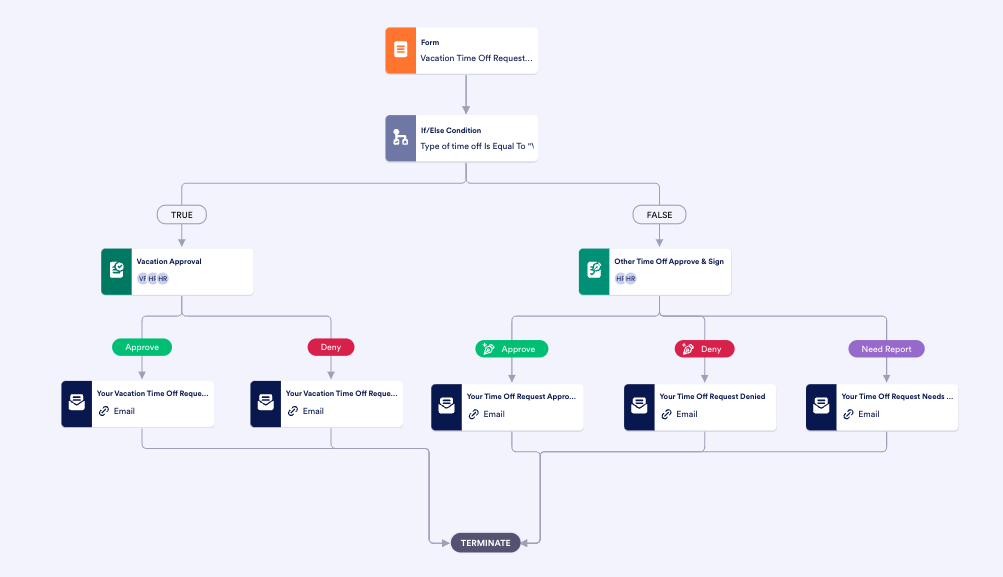How to manage employee time-off requests
- Revisit your policies
- Work together
- Consider out-of-the-box ideas
- Encourage employees and stay positive
- Make allowances when necessary
- Track judiciously
- Cross-train to prepare for absences
- Create a clear request template
- Automate the time-off request process
- Revisit and analyze policies
People aren’t machines that can run 24-7. If they work nonstop, they’ll almost certainly burn out, lowering the quality of their work and affecting their personal lives.
Still, in a culture that celebrates “the grind” and “no days off,” many are unwilling to ask for time off and watch the worry appear on their manager’s face when they utter the words “out of the office.” No wonder American workers left 768 million vacation days unused in 2018.
As a business owner, you want to keep your employees as happy and healthy as possible. Effectively managing employee time-off requests shows your employees you care about their work-life balance.
Plus, the support goes both ways, as employees who take vacations actually perform better at their jobs. This performance advantage is especially true for employees who believe that their organizations support vacation time and encourage breaks.
The importance of time-off request management
Thankfully, most people understand the value of giving workers time off. While employers in the United States aren’t required to provide paid vacations, you’ll rarely find a company that doesn’t offer salaried employees paid time off. Managing employee time-off requests is just one of the many skills employers have to master to keep their companies performing at top efficiency.
Strong time-off management also contributes to overall employee retention. In fact, many globally renowned companies attract the best talent because they’re known for their innovative time-off policies.
Moz offers 21 days of time off along with $3,000 to spend on vacations. Other companies adjust the traditional hour accrual system to give employees even more time off. With these companies making millions and setting high time-off management standards, there’s no reason your company’s vacation policies should be rigid and outdated.
Properly managing employee time-off requests benefits not only those in your company but those outside of it as well. It draws boundaries with clients and customers, and earns you the respect of others in your industry. Plus, the way you treat employees is a major factor in your attractiveness to potential employees.
Tips and tricks for managing employee time-off requests
Management is often a mosaic of different pieces that come together to form a whole that achieves business goals. Leave management is no different. Follow these tips to sharpen your leave management skills.
Revisit your policies
Managing employee time-off requests starts with creating a strong leave policy. The most basic foundation of these policies is the rule that they should address holidays (Labor Day, Christmas Day), life events (parental leave), and health (sick days, hospital stays).
But more critically, your policies should foster clarity and transparency by laying out rules all workers have to follow to ask for time off. For example, you may require employees to ask for time off at least three weeks in advance to accommodate work deadlines and other time-off requests. You can also institute all-hands-on-deck seasons when no one can request time off, or you can limit how many days in a row employees can take off.
To avoid overlapping requests, some companies institute a first-come, first-serve rule for time-off requests. Or they approve requests based on seniority. Even if these methods work for you, remember that it’s best when the policy doesn’t lean toward favoritism. One way to avoid this — whether you’re writing a new policy or reworking a current one — is to ask employees for their input and preferences.
Finally, your policies should outline the time-off request approval process, detailing the steps employees need to take to request time off and how managers approve requests in compliance with the policy and local laws.
Work together
The Harvard Business Review suggests employees can avoid time-off issues by planning vacations together, allowing them to step up to the plate to support each other and keep each other in the loop. Arranging regular meetings when employees plan time off together is perhaps the best way to avoid understaffing.
Consider out-of-the-box ideas
Maybe a standard paid time off (PTO) policy isn’t cutting it at your growing organization. Take some inspiration from the ways other high-performing companies handle time off. Some, like Netflix, offer unlimited vacation days so employees can take time off without needing to keep track of accrued PTO hours.
Others even have a minimum vacation mandate to encourage people to take time off, or they have company-wide seasons when the business is mostly closed. One of these ideas or a combination of them may work well for your company.
Encourage employees and stay positive
Even with a good policy, a culture that discourages team members from taking time off makes them feel uneasy. On the other hand, a culture that supports employees is one that makes them feel secure about their requests. Regularly remind your employees to take advantage of their time off and to take as much time as they need within policy mandates.
For managers, part of doing this means remembering that one of the most important aspects of managing employee time-off requests is showing a good attitude toward employees who want to take time off. Your attitude goes miles in making employees feel comfortable with their work and your leadership. Even if problems arise, show that you’re willing to make things work so everyone gets the time off they need as often as possible.
Make allowances when necessary
Leave room within your policy for extenuating circumstances, such as extended bereavement leave or emergencies. If the rules are clear and fair, employees will be unlikely to ask for exceptions unless absolutely necessary. When they do ask for exceptions, trust that they need them and be willing to hear them out.
This is where managerial discretion comes in. Seek advice from other managers about such situations so you’re not just making decisions based on your own experiences but on varied collective business knowledge.
Track judiciously
As with most other aspects of business, it’s important to gather as much data as you can when managing employee time-off requests. This data shows you gaps in your system to help you create better processes and continue developing a culture that balances employee needs for breaks with business efficiency.
Tracking also shows you who’s taking time off more often, allowing you to spot employees who may feel disengaged or need extra support. If you employ shift workers, tracking reveals who’s doing too many shifts or taking advantage of generous coworkers who regularly offer to cover for others.
Tracking may become the responsibility of a human resources professional who oversees all time-off requests and approvals to make sure everyone is following the rules. If this is the case in your company, you can regularly meet with human resources to go over time-off information.
Cross-train to prepare for absences
Nothing makes a harried workday worse than finding out the only person who can answer an urgent question is vacationing on a remote mountain with no cell service.
To make sure employee absences don’t seriously disrupt your day-to-day operations, train employees in a variety of tasks outside their scope of responsibilities. For example, an administrative assistant can actually relax during a one-week vacation if several other office workers on the team temporarily take on those responsibilities.
Doing this will prevent work from piling up, so employees won’t return refreshed from a vacation only to become quickly frazzled by all the extra work they need to catch up on.
Create a clear request template
To encourage employees to submit accurate requests, make request forms as clear and dynamic as possible. Your forms should also be online to eliminate paper clutter.
Jotform is a one-stop solution to create online forms. It offers a wide variety of time-off request form templates to get you started. Fully customizable, these templates simplify time-off requests by ensuring employees fill in all the information you need. Employees can even fill out the forms on their phones with the Jotform Mobile Forms app.
Automate the time-off request process
Automating your time-off request approval process is an essential element of managing employee time-off requests to consistently follow policies and prevent errors. An automation program keeps communication consistent while enforcing your policies.
The new Jotform Approvals supercharges automation. You can arrange forms, employees, and conditions in a drag-and-drop interface to create a workflow that’s simple and fast but also has enough checks and balances.
To get you started, Jotform Approvals also offers easy-to-customize workflow templates. In fact, you can actually use Jotform Approvals to automate all human resource processes so employees can handle all workflows with one tool.
Revisit and analyze policies
Each year, you should analyze what works and what doesn’t in your time-off policies to get better at managing employee time-off requests. These deep dives can lead to tweaks that optimize your time-off policies, making processes even faster and easier.
For example, you may find that it didn’t help your company to have three employees take time off during an especially busy budget closing period. You could institute a time-off blackout week for similar periods in the future to prevent staff from taking vacation.
Managing employee time-off requests is one more ball business owners have to juggle — but it’s one that pays back multiple dividends in productivity and success.
Want the full rundown on the topic? Check out the complete guide we created on human resource management.










































Send Comment: